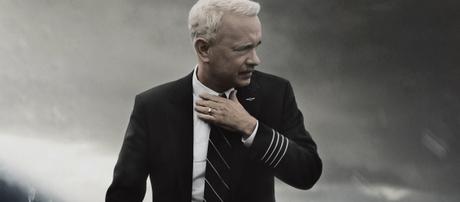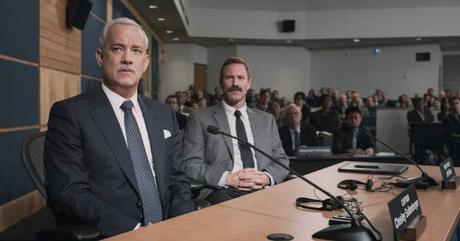
As written by Todd Komarnicki and directed by Clint Eastwood, Sully is a fascinating case study in screenwriting and story structure. However, it's also a very slight film which distorts the facts to create a false antagonist (which is forgivable) and leaves you with the creeping suspicion that cranky old Eastwood just wanted to show all of us kids what real men look like (which is less forgivable because it actually robs the story of depth).
It all starts with an obvious storytelling problem: How do you build a film around an emergency plane landing, the so-called "Miracle on the Hudson," which lasted all of 208 seconds? Moreover, how do you create tension when the majority of your target audience already knows the ending, specifically that Captain Chesley Sullenberger (Tom Hanks, doing the ole reliable Tom Hanks-Jimmy Stewart thing) successfully landed the plane in the Hudson River and everyone survived?
Komarnicki and Eastwood seem to have looked to Kurosawa's Rashomon for answers, mimicking the Japanese classic by dropping us into the story post-fact before repeatedly circling back to the actual plane landing via flashbacks told from differing points of view. If you are an uneasy flyer this might make for some upsetting viewing as the film keeps doling out the emergency landing piecemeal style in gripping, tense detail, jumping from the passengers and the flight attendants in one version to the air traffic controller's view in another before finally putting us into the cockpit to reveal what Sully and his co-pilot really did in those 208 seconds.
The mechanism they use to cue up the repeated flashbacks is an inquiry waged by the National Transporation Safety Board (NTSB), as represented largely by Mike O'Malley and Anna Gunn as two of the lead investigators, in the immediate aftermath of the landing. This introduces an air of uncertainty, drawing into question what we think we know about the "Miracle on the Hudson." When faced with an unprecedented scenario in commercial air flight history, did Captain Sullenberger and his co-pilot (Aaron Eckhart) truly behave heroically? Or did they needlessly endanger the lives of everyone on that plane not to mention the lives of the varied New York area rescue workers who were forced into action?

That being said, most "Based on a True a Story" movies are 70% bullshit. Sully is hardly the first to take such liberties, and while it creates artificial villains it does so in service to an effective bit of hero-worship and mystery-making. Moreover, the central question of whether or not Sully made the right call by picking the Hudson over several potential nearby runways is accurate and used quite cleverly by Eastwood and team. Holding back "here's what really happened in the cockpit during those 208 seconds" is the film's trump card, and it's played perfectly.
Really, if you subscribe to the line of criticism whereby you judge a film for what it is and wants to be as opposed what it's not Eastwood gets more right than wrong. However, I walk away from Sully feeling as if I learned nothing new about the title character (we glimpse two flashbacks to him as a younger man which mostly amount to "He used to fly other kinds of planes, ya know") nor have I gained any great new insight into the way we build up and tear down heroes in the media. Instead, I've been treated to a capably made procedural which functions as an ode to everyday heroism and the efficiency of disaster relief procedures in New York City. As a film, what makes it special, oddly, is not the exploits of the characters but the way in which the story is told. Without its nifty, modified Rashomon story structure, Sully would be little more than a glorified TV Movie of the Week (not that they actually make those anymore).
ROTTENTOMATOES CONSENSUS

